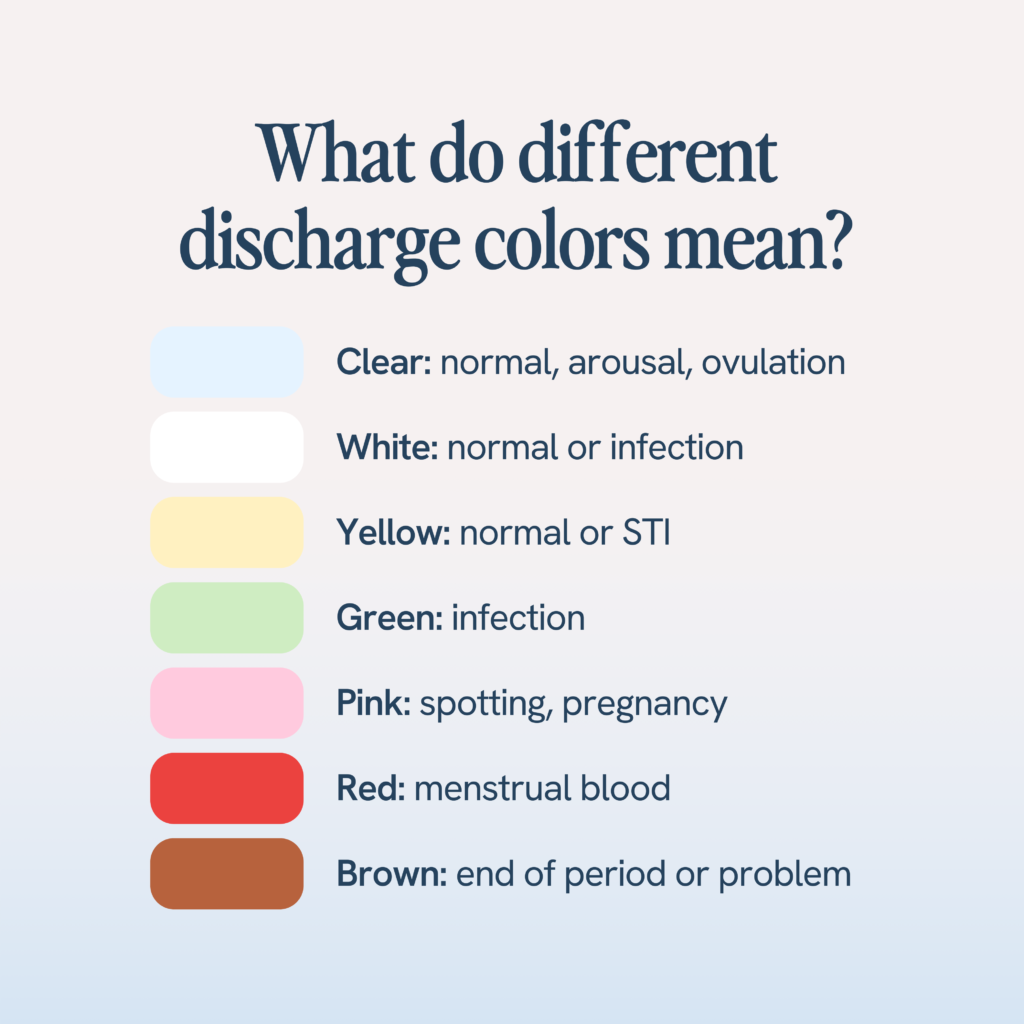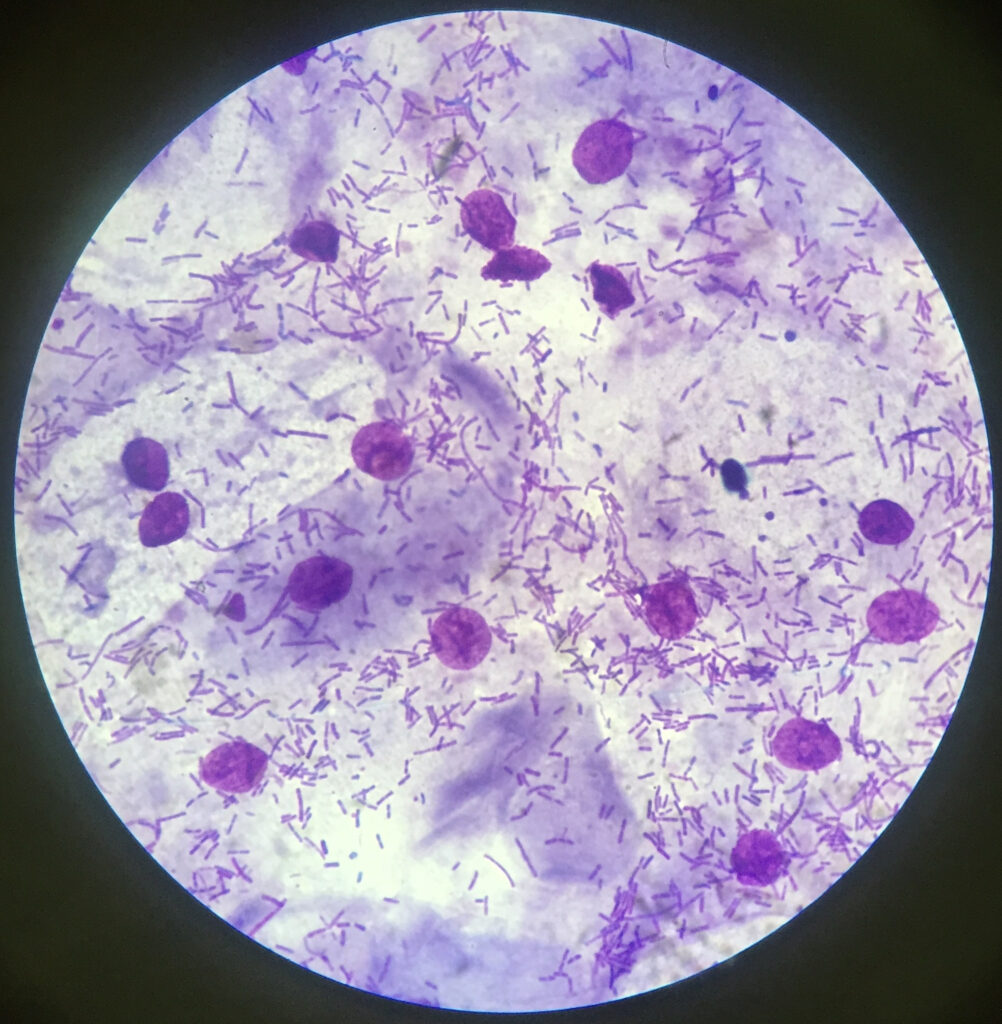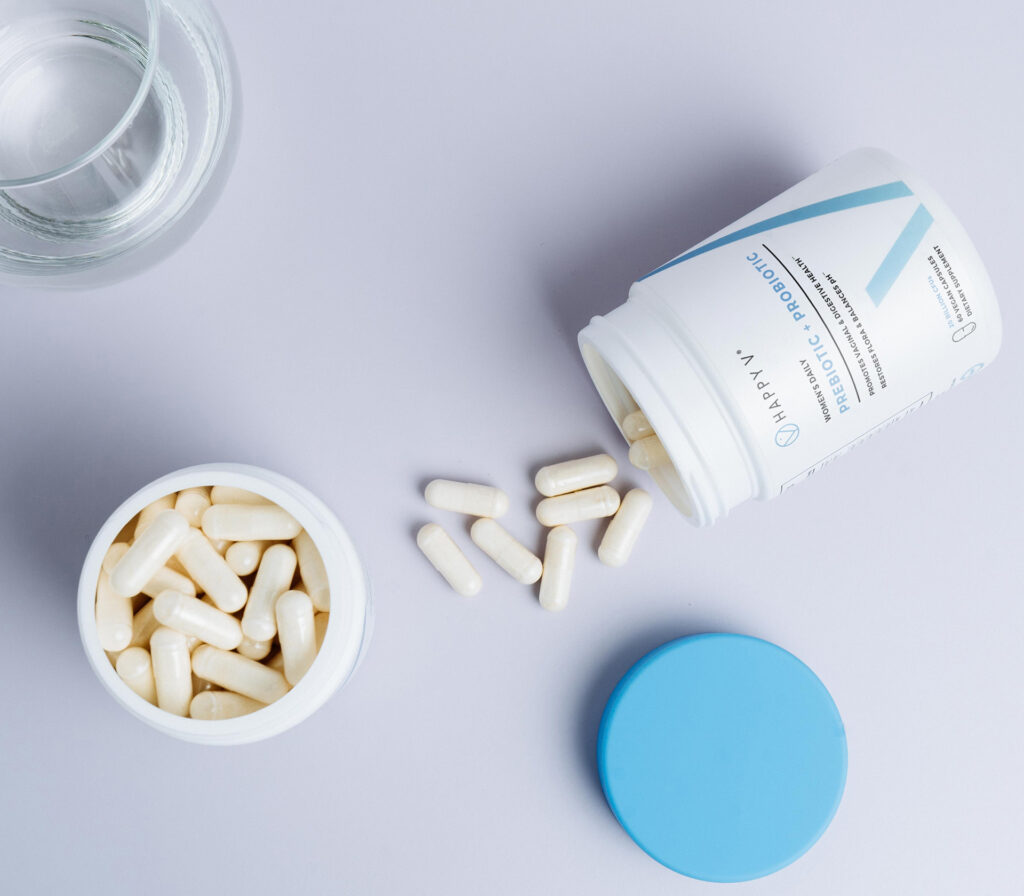- A change in your vaginal discharge color means your vagina is telling you something. Knowing the difference between normal discharge and atypical discharge can actually help you identify a yeast infection, a sexually transmitted infection like chlamydia, and even pregnancy!
- Unusual changes in consistency, like changing from thin to clumpy discharge, abnormal smells, and sudden changes in the color of discharge when combined can be an indication of a problem.
- If you’re experiencing a change in your regular discharge, pay close attention to foul odor, texture, vaginal itching, burning, and a change in color from clear to greenish—these are key indicators that you might have developed a vaginal infection or that you don’t have a healthy vagina.
The vagina is pretty incredible. It creates life, gives us pleasure, and cleans itself. The vagina can also talk to us! Well… not like that. But the vagina can tell us if it’s healthy or not through vaginal discharge.
If you care about your overall vagina wellness — and if you are reading this, you probably do! — it’s important to know the difference between normal and abnormal discharge. If you know what to look for, you can recognize the earliest signs of a yeast infection, a sexually transmitted infection (STI), or even pregnancy.
Here, we will discuss vaginal discharge colors and discharge consistency and what each of these means when it comes to your health. But first, let’s start with what vaginal discharge is and why it’s necessary in the first place.
What is Vaginal Discharge?

Vaginal discharge is a fluid created by tiny glands in your vagina and cervix. It might not seem like much, but it’s integral to overall vaginal health.
Healthy vaginal discharge:
- Removes dead skin cells
- Maintains lubrication of the vaginal tract
- Remove and potentially inhibit bacteria that cause infections like bacterial vaginosis (BV)
What does Vaginal Discharge look like?

Normal vaginal discharge varies in amount and can range in color from clear to milky white. Normal vaginal discharge can also have a slight odor, but if the odor is strong, foul, or has a sort of fishy smell, that’s a sign of infection.
What’s “normal” regarding discharge also changes depending on the time of the month and where you are in your menstrual cycle. For example, immediately after a period, there is almost no discharge. Two to three days after the period ends, the discharge reappears and is thick and white. And before ovulation, the discharge becomes clear and sticky. Like… that’s pretty amazing, right?!
And the definition of “normal” changes again if you are pregnant. The vaginal discharge of pregnant women is thin, white, milky, and mild smelling. And the influx of hormones also causes the overall discharge to increase during pregnancy.
Conversely, due to a drop in hormones, menopausal and perimenopausal women experience a decrease in overall discharge.
A great tip for keeping tabs on your vaginal discharge is to check your underwear. Discharge can build up on your panties, and in some cases, the acidity from your discharge can bleach the fabric. But don’t worry; this just means your vagina is healthy.
What causes changes in Vaginal Discharge?

We already mentioned how menstrual cycles, menstruation, pregnancy, and menopause can affect the appearance and amount of vaginal discharge.
Sex and sexual relations can also cause temporary changes to your vaginal discharge, as well as other life events, including:
- Medicines or hormones used in the treatment of breast cancer, endometriosis, fibroids, or infertility
- Surgery to remove the ovaries
- Radiation treatment to the pelvic area
- Chemotherapy
These events can cause estrogen levels to drop, resulting in little to no vaginal discharge.
But even more everyday lifestyle choices can have an impact on our vaginal discharge, including:
- Diet and hydration
- Exercise intensity
- Stress
And, of course, infections can change the appearance and consistency of our vaginal discharge. Some of the most common infections that affect discharge include:
- Bacterial Vaginosis
- Trichomoniasis
- Yeast Infections
- Sexually transmitted infections (STIs) and sexually transmitted diseases (STDs)
Does the color of my Vaginal Discharge matter?
Short answer? Yes.
Longer answer? Though normal vaginal discharge is usually clear or white, there are times when it can be yellow, pink, or brown. What you want to look for is a sudden change in discharge color and any sudden changes in consistency or smell.
One recent study found that sudden changes in discharge color, abnormal smell, and unusual changes in consistency, like changing from thin to clumpy discharge, can indicate a problem. (1)
If you do notice your discharge color changes suddenly, look for other symptoms of infection like foul odor, vaginal itching, or burning during urination. Be especially mindful if you have started having sexual intercourse with a new partner or recently changed your birth control method since these life changes can put you at higher risk for developing a vaginal infection.
What do different vaginal discharge colors mean?

Clear Vaginal Discharge
Clear or clearish-white vaginal discharge is what most would consider to be normal. The clear color indicates that the discharge hasn’t accumulated dead skin cells, bacteria, blood, or infection.
Your body will also release clear vaginal discharge during sexual arousal as well as during ovulation. This increased vaginal fluid during ovulation is intended to make it easier for the sperm to reach the eggs for fertilization.
Clear vaginal discharge can also be one of the earliest signs of pregnancy, as the cervix and vaginal wall soften and increase the production of vaginal fluids to prepare the body to support life.
White Vaginal Discharge
White vaginal discharge could be normal or abnormal. Oftentimes, white discharge is a natural form of lubrication. Like clear discharge, it is often released during sexual arousal, pregnancy, or ovulation.
When it comes to spotting abnormal white discharge, we look at the consistency of the discharge and the smell of the discharge.
Thin white discharge
A thin white discharge is a normal, healthy form of lubrication. You may notice the amount of this discharge increase during exercise or sexual activity.
Thick White Discharge
During ovulation, the white discharge can become thicker. This is entirely normal.
However, if you ever notice your thicker discharge is accompanied by a foul fishy odor, intense itching, or severe burning, that’s a sign you might have BV or a vaginal yeast infection.
Thick White, Clumpy Discharge
When discharge becomes thick and clumpy, almost cottage cheese-like in appearance, that’s a good sign you are experiencing a yeast infection. Yeast infections are often accompanied by unusual smell, itching and burning, or pain during sexual intercourse. Yeast infections can be treated using antifungals, like Fluconazole, which can be purchased over-the-counter, but if you ever suspect an infection of any kind, it’s always best to make an appointment with your gynecologist. They can help confirm a diagnosis and recommend the best course of treatment, whether that’s an over-the-counter medication or a prescription antifungal. Although considered normal vaginal discharge, you can have a yeast infection and still experience white discharge.
When you have signs of bacterial vaginosis or yeast infections, taking a high-quality probiotic can help.
In a double-blind, placebo-clinical study involving 48 women who took either a placebo or the two main probiotics in Happy V’s Pre+Pro, women saw a significant decrease in vaginal discharge related to both yeast infections and bacterial vaginosis.
Light Yellow Discharge
Vaginal discharge that’s slightly yellow in appearance is considered normal. The light yellow color often results from changes in diet or hydration or is a sign the discharge is richer in bacteria.
Dark Yellow to Green Discharge
While slightly yellow discharge is normal, vaginal discharge that’s dark yellow or greenish in appearance is not and could be a sign of a bacterial infection or an STI. We’ll talk about some of the most common culprits for green discharge, including BV, Bacterial vaginosis, Trichomoniasis, Gonorrhea, Chlamydia, and Pelvic Inflammatory Disease (PID), but don’t try to self-diagnose. If you ever notice this kind of vaginal discharge, and especially if you notice it alongside vaginal itching or redness, go to your OB-GYN for diagnosis and treatment.
Gonorrhea and Chlamydia
Gonorrhea and chlamydia are common STIs resulting from bacterial overgrowth. Gonorrhea is caused by a bacterium called Neisseria, and the spread of Chlamydia trachomatis causes chlamydia. These infections result in a yellowish discharge, foul smell, and extreme burning. (6) These infections might also affect the cervix, so make an appointment with your OB/GYN or primary healthcare provider as soon as you notice symptoms.
Trichomoniasis
Trichomoniasis is another sexually transmitted infection caused by the parasite Trichomonas vaginalis. It’s sometimes asymptomatic, meaning you can have it but not experience any symptoms, but more frequently, it is accompanied by a yellow or green vaginal discharge that’s frothy in appearance. It’s essential to seek treatment ASAP since trichomoniasis is not only spread through unprotected sex but also through sharing bathing suits or towels.
Genital Herpes
This sexually transmitted infection (STI) can cause a foul-smelling, thick vaginal discharge, especially after sexual activity. Other symptoms include a burning feeling when urinating, soreness around the genitals, and bleeding between periods.
Herpes cannot be cured, but you can make a management plan with your healthcare provider to lessen recurrent episodes.
Pelvic inflammatory disease (PID)
PID is a severe infection of the female reproductive system that is often the result of untreated BV, gonorrhea, or chlamydia. Along with unusual discharge, it’s also often accompanied by dull pain, irregular periods, or even fever. PID is considered serious because it can damage your cervix, fallopian tubes, or ovaries, so please seek treatment immediately if you ever suspect it.
Green to Gray Vaginal Discharge
The most common culprit for gray discharge that’s also thinner than usual is bacterial vaginosis or BV. Other symptoms of BV include redness around the vulva, irritation, vaginal itching, and a foul odor or fishy smell.
Oftentimes, BV requires antibiotics like Metronidazole and Clindamycin to clear. It can also be helpful to pair these antibiotics with a daily probiotic to prevent recurrence.
Green or grayish discharge that appears cloudy and is accompanied by painful urination may indicate pus or an abscess in your vagina. We know “abscess” sounds kind of scary, but it can often be treated quickly and thoroughly with a round of antibiotics.
Pink Vaginal Discharge
If your vaginal discharge is pink, that means it contains a small amount of blood. Usually, this is normal and is often associated with spotting before a period. If you notice pink discharge after sexual intercourse, this can indicate rough sex that caused a minor tear in your vagina or cervix.
Pink discharge can also be one of the earliest signs of pregnancy and indicates implantation of the fertilized egg to the uterine wall.
Red Vaginal Discharge
As you might imagine, red vaginal discharge is often a result of your menstrual cycle, and it usually doesn’t indicate anything serious. If you’re in the middle of your period, you may have heavy flow, which causes red vaginal discharge.
Brown Vaginal Discharge
Brown vaginal discharge is also usually normal and linked to the stage of your menstrual cycle.
Brown vaginal discharge is normal when it appears at the end of your period. However, there are times when brown discharge is a sign that something could be wrong.
If you are pregnant and notice red or brown discharge, this could be due to changing hormones and normal spotting, but it also could be a sign of miscarriage, especially if it is accompanied by any dizziness, abdominal pain, or contractions. (5) Call your doctor so they can see you right away.
And if you aren’t pregnant and have brown discharge at unusual times during your menstrual cycle, this could indicate PID, which we discussed earlier, or cervical cancer. Of course, these also require follow-up with a healthcare provider, like your OB-GYN.
Unfortunately, red or brown discharge can also signify a serious medical condition. If you are already pregnant and notice red or brownish discharge, this could mean you are having a miscarriage. In very rare cases, red or brownish discharge might indicate PID or ovarian or cervical cancer. (7)
How does vaginal discharge change during your life?

Vaginal discharge is deeply associated with hormones and overall hormone levels, so it will naturally change throughout puberty, adulthood, pregnancy, and menopause. We’ve already talked about some of these things in passing, but let’s talk about it a little more in-depth now because the female body is truly amazing.
Prepubescent girls do not experience any vaginal discharge. In fact, vaginal discharge does not appear until 1-6 months before the first period. After that, the body will release vaginal discharge regularly, and the vaginal discharge will vary depending on where you are in your menstrual cycle, from thick to thin, almost absent to abundant, and sticky to non-sticky.
Once you become pregnant, vaginal discharge changes due to hormonal shifts and increased mucus production by the cervix. Spotting and brown or red vaginal discharge isn’t unusual for some women, especially in the first trimester, but they could also be signs of a miscarriage if accompanied by pain or contractions.
After pregnancy, vaginal discharge follows the same patterns as pre-pregnancy, with the next change coming with menopause. As estrogen levels drop, there is a pronounced decrease in vaginal discharge, which can lead to vaginal dryness and pain with intercourse. For those reasons, vaginal moisturizers, lubricants, or estrogen creams can be helpful during this stage of life. See a doctor for a prescription.
How can I avoid abnormal changes in vaginal discharge?

Maintaining healthy vaginal discharge is a matter of practicing good vaginal hygiene. The best practices include:
- Avoiding scented creams, soaps, and vaginal cleaners. These products might smell fantastic, but they all have chemicals that disrupt normal pH levels, allowing harmful bacteria to overgrow good bacteria, which changes your vaginal microbiome and the discharge it produces. If you do want to wash the area, simply opt for warm water and mild, unscented soap. Your vagina will take it from there (it is self-cleaning, after all).
- No douching. Again, the vagina cleans itself naturally, so there’s no real need for douches. More than that, vaginal douches clean out good bacteria along with bad ones, which can change your microbiome and make you more prone to discharge-altering infections.
- Use protection when having sex, and avoid having multiple sexual partners. Sex, while wonderful, also exposes you to harmful bacteria and microbes from the other person’s body. So, consider using protection and avoid engaging with too many multiple sexual partners. But also, don’t be afraid to have open conversations with your partner about any unusual symptoms you experience to avoid getting or spreading infections. Remember, as a couple, you are in this together!
- Adding probiotics to your diet. Probiotics are essential to supporting not only gut health but vaginal health. They help good bacteria to flourish while keeping bad bacteria in check. You can get probiotics through foods like yogurt, but many find it easier to get daily probiotics through a probiotic supplement.
Our Happy V® Prebiotic + Probiotic was created for anyone who is experiencing symptoms related to Bacterial Vaginosis and Yeast Infections. Eliminate the odor, itch, gut bloating, and other symptoms.
- Changing tampons or pads frequently. And by “frequently,” we mean every 2-4 hours. Letting feminine products sit in your vagina too long can alter your vaginal pH, leading to irregular discharge and infection.
- Changing clothes following workouts or swims. Bad bacteria thrive in dark, damp environments, so change clothes after you get sweaty or swim. Also, consider changing the type of underwear you wear since cotton is more breathable than other synthetic fabrics like nylon.
What are signs I need to see a healthcare provider concerning unusual discharge?
We covered the concerning colors and symptoms of vaginal discharge further up in the article, but generally, it’s a good idea to call a healthcare provider as soon as you experience discharge that’s:
- Thick, white, and cottage cheese-like
- Associated with a foul odor or fishy smell
- Accompanied by any kind of itching, burning, or pain with urination
These are all signs of vaginal infections, like vaginal yeast infections and BV, which often require a prescription to resolve and can lead to more severe infections like PID if left untreated.
Knowing the Difference Between Healthy Discharge and Abnormal Discharge Can Help You Have a Happy V
While the thought of vaginal discharge may have made you uncomfortable before, after reading this, we hope you see it for the amazing thing that it is. The colors and textures of your vaginal discharge are your vagina’s way of telling you what’s happening in your body, and by remembering what we discussed here, you will be able to pay attention to what your body is saying and take control of your vaginal wellness.
-
- WebMD, How should you clean your vagina. https://teens.webmd.com/girls/qa/how-should-you-clean-your-vagina
- Eschenbach, D. A., Hillier, S., Critchlow, C., Stevens, C., DeRouen, T., & Holmes, K. K. (1988). Diagnosis and clinical manifestations of bacterial vaginosis. American journal of obstetrics and gynecology, 158(4), 819-828.
- Mayoclinic, Vaginal Yeast Infections. https://www.mayoclinic.org/diseases-conditions/yeast-infection/symptoms-causes/syc-20378999
- Shapiro, R. A., Schubert, C. J., & Myers, P. A. (1993). Vaginal discharge indicates gonorrhea and Chlamydia infection in girls under 12 years old. Pediatric emergency care, 9(6), 341-345.
- Centers for Disease Control and Prevention, Diseases characterized by vaginal discharge. https://www.cdc.gov/std/tg2015/vaginal-discharge.htm
- WebMD, Vaginal discharge—What’s abnormal?. https://www.webmd.com/women/guide/vaginal-discharge-whats-abnormal#1
- Al Quaiz, J. M. (2000). Patients with vaginal discharge: A survey in a university primary care clinic in Riyadh city. Annals of Saudi Medicine, 20(3-4), 302-306.
- WHO, Guidelines for the management of sexually transmitted infections. https://apps.who.int/medicinedocs/en/d/Jh2942e/3.4.2.html
- Centers for Disease Control and Prevention, Vulvovaginal Candidiasis. https://www.cdc.gov/std/tg2015/candidiasis.html
- Centers for Disease Control and Prevention, Bacterial Vaginosis. https://www.cdc.gov/std/tg2015/bv.htm
- Krasnopolsky, V. N., Prilepskaya, V. N., Polatti, F., Zarochentseva, N. V., Bayramova, G. R., Caserini, M., & Palmieri, R. (2013). Efficacy of vitamin C vaginal tablets as prophylaxis for recurrent bacterial vaginosis: a randomized, double-blind, placebo-controlled clinical trial. Journal of Clinical Medicine Research, 5(4), 309.
- Genet, J. (1995). Natural remedies for vaginal infections. SIDAhora: un proyecto del Departamento de Publicaciones del PWA Coalition, NY, 40.
Women who used Happy V Pre+Pro experienced improvements in their vaginal health.*
- A-
- A+
Women who used Happy V Pre+Pro experienced improvements in their vaginal health.*






